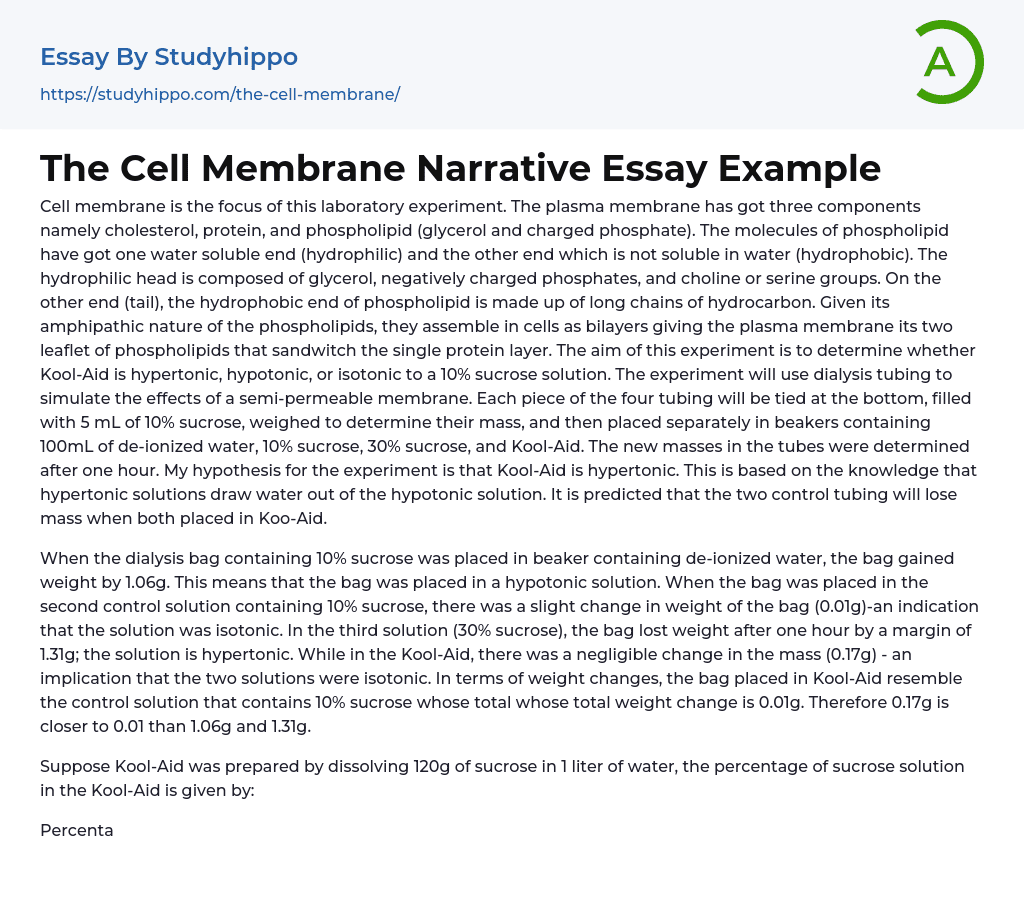The laboratory experiment investigates the components of the cell membrane, such as cholesterol, protein, and phospholipids. Phospholipids consist of a hydrophilic head with glycerol, negatively charged phosphates, and choline or serine groups. They also have a hydrophobic tail made up of long chains of hydrocarbon. These amphipathic phospholipids form bilayers in cells called the plasma membrane's two leaflets.
The objective of this experiment is to determine the tonicity of Kool-Aid compared to a 10% sucrose solution using dialysis tubing as a simulation for a semi-permeable membrane. Each tube will be tied at the bottom, filled with 5 mL of 10% sucrose solution, weighed, and then placed in separate beakers containing de-ionized water, 10% sucrose solution, 30% sucrose solution, and Kool-Aid. After one hour, the masses of the tubes will be measured.
Based on my hypothesis that
...Kool-Aid is hypertonic because hypertonic solutions draw water out from hypotonic solutions; it is predicted that both control tubes will experience weight loss when placed in Kool-Aid. The first control tube with 10% sucrose gains weight by 1.06g when placed in de-ionized water indicating it is hypotonic. In contrast, there is only a slight change in weight by 0.01g for the second control tube with 10% sucrose suggesting an isotonic solution. After one hour in the third solution with 30% sucrose concentration, the dialysis bag loses weight by 1.31g indicating a hypertonic solution.When the same dialysis bag was immersed in Kool-Aid, it experienced minimal change in mass (0.17g), indicating that the Kool-Aid is isotonic with a control solution containing 10% sucrose. It is noteworthy that my grandmother's Kool-Aid has a higher sucrose concentration compared to the lab version. In order to
determine the exact percentage of sucrose in my grandmother's Kool-Aid, I dissolved 120g of sucrose in 1 liter of water, resulting in a calculated percentage of 12%. If a dialysis bag with a 10% sucrose solution is placed into my grandmother's Kool-Aid, it would lose weight due to its hypertonic property. Based on this hypothesis, I predicted that the Kool-Aid would be hypertonic compared to the dialysis bag containing a 10% sucrose solution. However, the experimental results did not confirm this prediction and contradicted my initial hypothesis. The recorded mass of the dialysis bag before and after the experiment was 5.51g and 5.34g respectively.
- Organic Chemistry essays
- Acid essays
- Calcium essays
- Chemical Bond essays
- Chemical Reaction essays
- Chromatography essays
- Ethanol essays
- Hydrogen essays
- Periodic Table essays
- Titration essays
- Chemical reactions essays
- Osmosis essays
- Carbohydrate essays
- Carbon essays
- Ph essays
- Diffusion essays
- Copper essays
- Salt essays
- Concentration essays
- Sodium essays
- Distillation essays
- Amylase essays
- Magnesium essays
- Acid Rain essays
- Bacteria essays
- Biotechnology essays
- Breeding essays
- Cell essays
- Cell Membrane essays
- Cystic Fibrosis essays
- Enzyme essays
- Human essays
- Microbiology essays
- Natural Selection essays
- Photosynthesis essays
- Plant essays
- Protein essays
- Stem Cell essays
- Viruses essays
- Agriculture essays
- Albert einstein essays
- Animals essays
- Archaeology essays
- Bear essays
- Biology essays
- Birds essays
- Butterfly essays
- Cat essays
- Charles Darwin essays
- Chemistry essays




